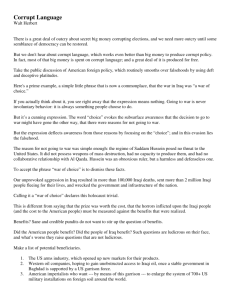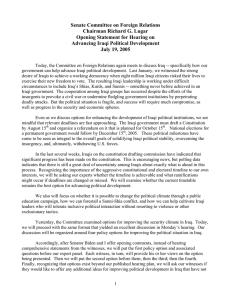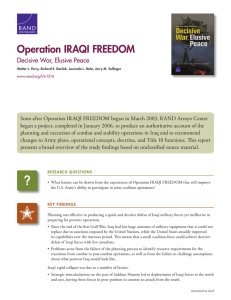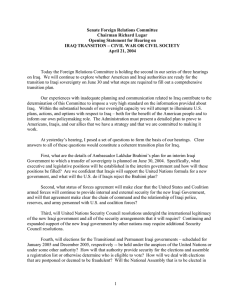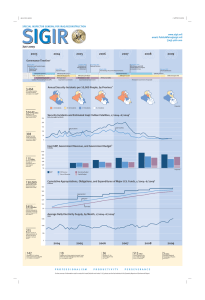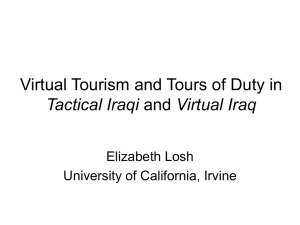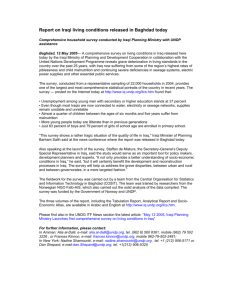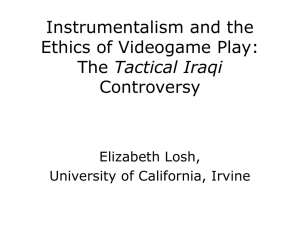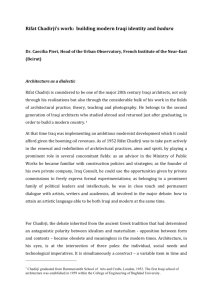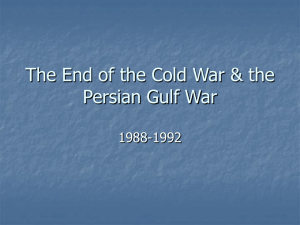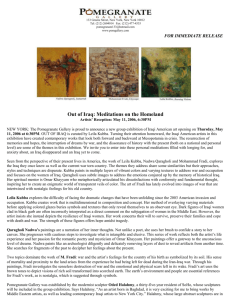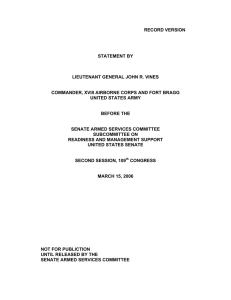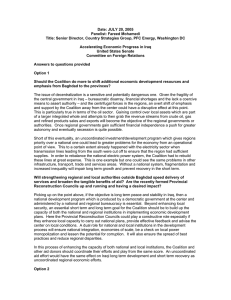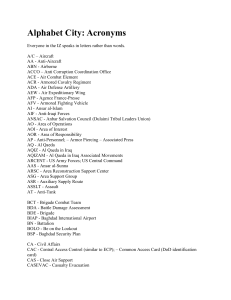education in iraq - UNDG Technical working group in Iraq
advertisement
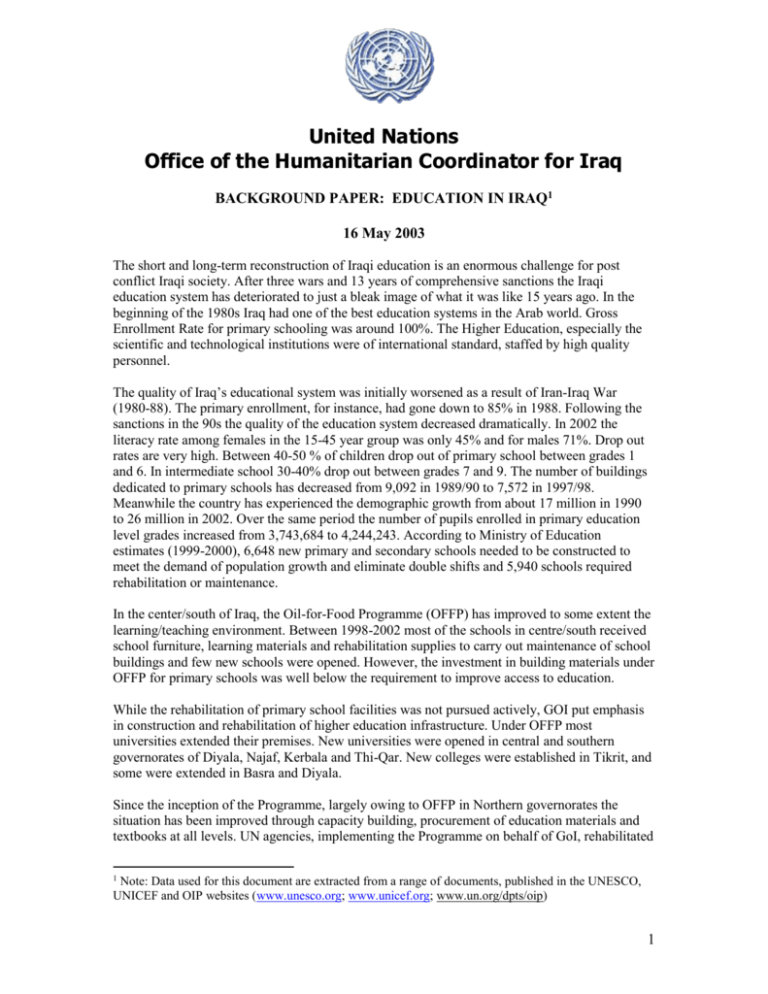
United Nations Office of the Humanitarian Coordinator for Iraq BACKGROUND PAPER: EDUCATION IN IRAQ1 16 May 2003 The short and long-term reconstruction of Iraqi education is an enormous challenge for post conflict Iraqi society. After three wars and 13 years of comprehensive sanctions the Iraqi education system has deteriorated to just a bleak image of what it was like 15 years ago. In the beginning of the 1980s Iraq had one of the best education systems in the Arab world. Gross Enrollment Rate for primary schooling was around 100%. The Higher Education, especially the scientific and technological institutions were of international standard, staffed by high quality personnel. The quality of Iraq’s educational system was initially worsened as a result of Iran-Iraq War (1980-88). The primary enrollment, for instance, had gone down to 85% in 1988. Following the sanctions in the 90s the quality of the education system decreased dramatically. In 2002 the literacy rate among females in the 15-45 year group was only 45% and for males 71%. Drop out rates are very high. Between 40-50 % of children drop out of primary school between grades 1 and 6. In intermediate school 30-40% drop out between grades 7 and 9. The number of buildings dedicated to primary schools has decreased from 9,092 in 1989/90 to 7,572 in 1997/98. Meanwhile the country has experienced the demographic growth from about 17 million in 1990 to 26 million in 2002. Over the same period the number of pupils enrolled in primary education level grades increased from 3,743,684 to 4,244,243. According to Ministry of Education estimates (1999-2000), 6,648 new primary and secondary schools needed to be constructed to meet the demand of population growth and eliminate double shifts and 5,940 schools required rehabilitation or maintenance. In the center/south of Iraq, the Oil-for-Food Programme (OFFP) has improved to some extent the learning/teaching environment. Between 1998-2002 most of the schools in centre/south received school furniture, learning materials and rehabilitation supplies to carry out maintenance of school buildings and few new schools were opened. However, the investment in building materials under OFFP for primary schools was well below the requirement to improve access to education. While the rehabilitation of primary school facilities was not pursued actively, GOI put emphasis in construction and rehabilitation of higher education infrastructure. Under OFFP most universities extended their premises. New universities were opened in central and southern governorates of Diyala, Najaf, Kerbala and Thi-Qar. New colleges were established in Tikrit, and some were extended in Basra and Diyala. Since the inception of the Programme, largely owing to OFFP in Northern governorates the situation has been improved through capacity building, procurement of education materials and textbooks at all levels. UN agencies, implementing the Programme on behalf of GoI, rehabilitated 1 Note: Data used for this document are extracted from a range of documents, published in the UNESCO, UNICEF and OIP websites (www.unesco.org; www.unicef.org; www.un.org/dpts/oip) 1 and constructed over 1444 primary schools, 276 secondary schools and 33 institutions of higher education. As a result of the increased availability of educational facilities most schools have started to operate in two rather than three shifts. The disparity in investment and assistance level between the three northern governorates and the center/south is reflected in significant differences in indicators for access to education. In the north, between 1995/1996 and 2001/2002 primary schools enrollment increased by 77%, in secondary education by 103% and in higher education by 76%. In the center/south, during the same period, primary enrolment increased by 21%, secondary by 3.8% and in higher education by 28%. On the whole Iraqi teachers are well qualified, but reduction in teacher salaries from 500-1000 dollars per month in 1990 to 5-10 dollars today has resulted in increased turnover of teachers looking for better paid jobs elsewhere. Besides, in service training of teachers and school management staff has been more or less non-existent during the last decade, particularly in center/south. Curricula and textbooks have not been revised for about two decades, and teaching methodologies are not updated. The challenges ahead are immense. The Iraqis have a strong tradition and motivation for education and are committed to rebuilding the system. Before the hostilities started, school year was disrupted for almost 6 million Iraqi children and youth. In the north the schools were reopened shortly after the collapse of the regime; however many school buildings needed rehabilitation. There was some minor damage in 90% of 179 schools occupied by IDPs. In the center/south the government forces used many schools as ammunition depot. It is not clear how many schools have been damaged and looted during and after the conflict. Higher educational institutions, laboratories and libraries, being much better equipped than primary and secondary schools, have suffered extensive damage. Following UNICEF call to resume studies without delay a number of schools have been reopened in Baghdad in spite of the fact that the coalition forces still classify Baghdad as “an uncertain environment”. In fact, a large number of unexploded ordnance in the streets and insecure situation in general does affect attendance rate. In addition, absence of teachers (apparently due to lack of fuel for transportation), and parents keeping children at home due to both insecurity and confusion about the curriculum remain major constraints. Of particular concern is the extremely low rate of girls’ attendance owing to insecurity. Overall, psychological trauma of both teaching personnel and students could also affect the beginning of teaching/learning process. A number of challenges are envisaged for the reconstruction of the Education system. There is one short-term and one long-term perspective. The short-term perspective is to get more students back to educational institutions and normalcy as soon as possible. Measures have to be taken immediately to ensure that students can take their exams and not lose a whole school year due to the conflict. Schools, which are in such bad condition after the war that they simply cannot be used, for example, due to lack of water and sanitation facilities, will have to be rehabilitated immediately and provisional “buildings” acquired where necessary in order to keep education going. Areas, which have been strongly affected by fighting, will have to be cleared of mines and explosives, and activities to do this should be stepped up. Necessary and basic teaching learning material (School in a box), student desks and office stationary will have to be supplied. Students, teachers and management will be encouraged to go back to education, if necessary mobilization campaigns will be considered. Teacher salaries, which have not been paid for the last two months, will have to find a solution immediately. Basic psychosocial training of head teachers and teachers to help identify and support children and adolescents with conflict related problems will have to be implemented. One 2 of the main challenges in the short-term perspective is to acquire enough donors to be able to supply what is needed within a very short period of time. The long-term perspective of rebuilding Iraqi education to an internationally satisfactory level will have to take years and a lot of resources. It must be up to the Iraqis themselves to set the attainment targets for this work and decide structure and contents of their future education system. There is little doubt, however, that some of the most important challenges will be to Raise the attendance levels in preschool, primary, secondary, vocational, tertiary and non-formal education. Increase the literacy rate to previous levels, with particular attention to female literacy rates. Reduce gender imbalance in enrollment and attendance on the various levels of basic and secondary education and pay special attention to the increasing feminization of the teaching profession. Reduce drop out rates considerably in primary, secondary and vocational education. Reduce repetition rates as repetition may be seen as a great waste of resources in any country. Renovate, rehabilitate and build new schools to reduce the number of double and triple shifts, and without being tempted to raise the average student teacher ratio by putting even more students into already crammed classrooms. Educate enough teachers to keep pace with increased attendance rates on the various levels of education and retain qualified teachers by way of decent salaries and other incentives. Revise curricula and textbooks and train all teachers in new curricular contents, new and student friendly teaching methodologies and constructive interaction with the local community and with parents. Provide pedagogical support material to help teachers attain high quality levels of teaching. Develop a program of information and communication technologies for all teachers and pupils. Revise examination and evaluation systems in accordance with new curricula and new teaching methods. 3

